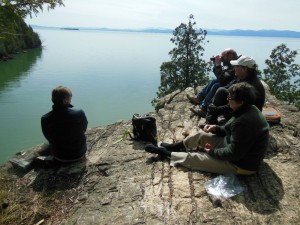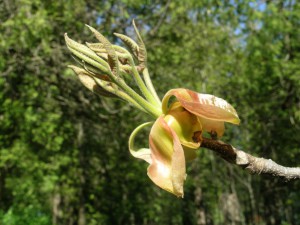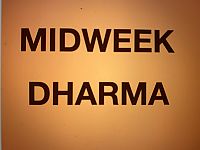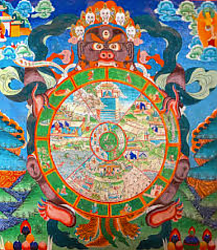A different kind of Flower Show – Or: Everything is Connected, and Everything Changes
The term phenology refers to the study of the cyclical changes that occur in nature with the turning of the seasons. We are especially aware of these changes at this time of year, when the transformation from a cold, quiet world of black, white and gray to a world of vibrant color captures our attention. In a sense, phenology parallels the Buddhist notion of impermanence, as each change we see in the landscape lasts for only a short time. My own exploration of phenology began with a striking red-and-black bird, and led to all kinds of other discoveries, including what I call the annual “flower show-in-the-woods.”
With its eye-popping red-and-black plumage, identifying the bird as a scarlet tanager was not particularly difficult. In the process, though, my previous catch-all mental category for birds became painfully insufficient. Now I had to know what other birds were out there — What was that tiny yellow streak over there? What about that majestic-looking creature scanning the surface of the pond for movement from its perch on a dead tree? From then on, getting to know the birds gave me a whole new way of discovering trees – not only as individuals, but as “the woods” – and not just generic woods, but microcosms of particular plants, soil conditions, and topography where birds and other animals don’t just appear randomly. One aha-experience was noticing that wherever I could hear the song of the hermit thrush, I could also count on smelling the scent of balsam firs.
Another discovery I have the scarlet tanager to thank for is the kind of flower show many trees put on each spring. Botanically speaking, the particular flower that opened my eyes to this annual phenomenon turned out not to be a flower at all — but it might as well count as an honorary one, with its pastel tones of orange and cream and its petals elegantly curved back, reminiscent of a Georgia O’Keeffe painting. It belonged to an enormous shagbark hickory, and the supposed flower was actually made up of the bud scales that unfurl with the hickory’s new leaves. Shagbark hickories, I later came to learn, are one of the major tree species in limestone bluff cedar-pine forests, a natural community of which Burlington is fortunate to harbor a prime example at the Episcopal Diocese of Vermont’s beautiful Rock Point property.
Flower or bud scale — from the day of my shagbark hickory encounter on, I looked much more closely at both on my walks in the woods and around the neighborhood. Noticing the flowers on the various species of maple became an exhilarating spring hobby, and I had to be quick about it – the flowers on some trees last only a few days.
Beyond the sheer fun of getting to know the trees better by their flowers, this new hobby tuned me in to patterns in time – when do the sugar maples begin to flower? compared to red maples? compared to boxelders?
These kinds of observations have meaning beyond the personal. Considering how closely events in the natural calendar are intertwined, we should pay attention to such changes — think only of fact that at least one-third of the world’s agricultural crops depends on pollination by insects or other animals. Records kept by regular people with a knack for observation have been analyzed by the National Phenology Network and show that the first flowering of some species now occurs an average of five days earlier than it did in 1955.
To notice these kinds of things about birds, trees, and flowers – to transition from knowing the pieces of the natural world to noticing patterns – takes time; just as getting to know people does. Anyone with an interest in the natural world can begin taking notes on the plants in their backyards or in their surroundings. There are many excellent resources to help jump-start and inform one’s observations: Mary Holland’s Naturally Curious: A Photographic Field Guide and Month-by-Month Journey through the Fields, Woods, and Marshes of New England is a great place to start, and a phenology manual developed by David Weinstein of Cornell University is available at http://budbreak.tc.cornell.edu/downloads/BudBreak_manual.pdf.
 Anyone interested in joining our quarterly field walks at Rock Point please contact [email protected] or [email protected]. The next one is scheduled for Sunday, July 27!
Anyone interested in joining our quarterly field walks at Rock Point please contact [email protected] or [email protected]. The next one is scheduled for Sunday, July 27!
An earlier version of this article was aired as a commentary on Vermont Public Radio.






